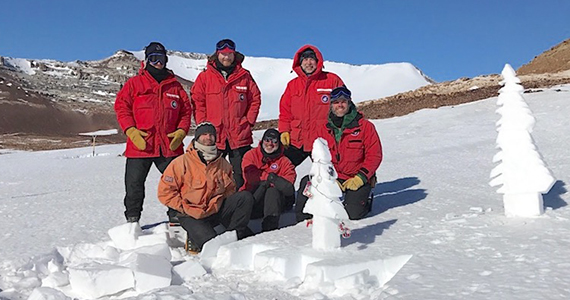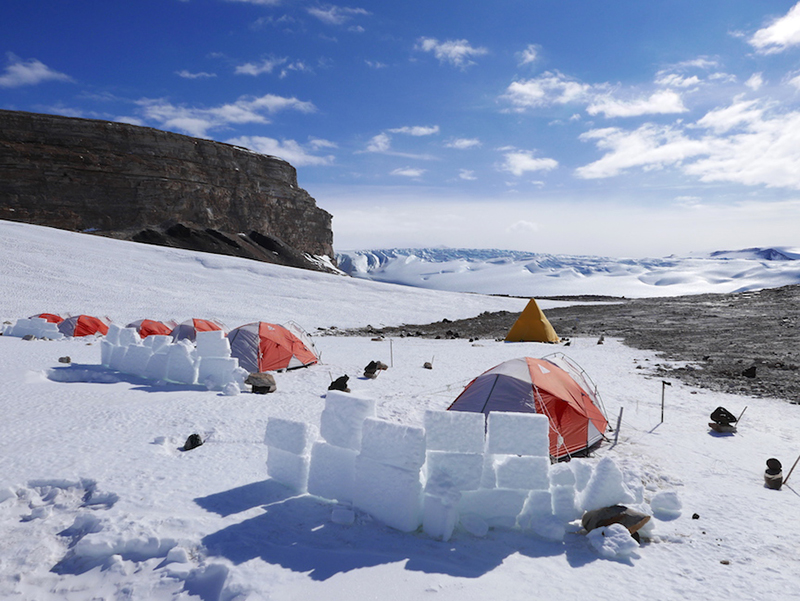Ted Daeschler Checks in from Antarctica
 Christmas Day at Camp 1 with makeshift trees and decorations. Top row (L – R): John Long, Tim Senden, Ted Daeschler. Bottom row (L –R): Sune Tamm-Buckle, Neil Shubin, Adam Maloof.
Christmas Day at Camp 1 with makeshift trees and decorations. Top row (L – R): John Long, Tim Senden, Ted Daeschler. Bottom row (L –R): Sune Tamm-Buckle, Neil Shubin, Adam Maloof.
January 17, 2017
Ted Daeschler, PhD, recently completed an expedition to explore Antarctic rocks dating to the Devonian Period, a time that ended some 120 million years before the first dinosaurs appeared. You might call that an expedition of a lifetime, except that he plans to go back again in two years!
The handful of colleagues that he traveled with were the only living things he saw once he reached the field site; only bacteria and maybe some lichens exist where he went.
The Academy of Natural Sciences of Drexel University thought it would be fun to have Ted describe his odyssey in his own words. Before he left he made this short video describing his upcoming trip. To go along on the adventure, read Part One, Part Two and Part Three, then check out Part Four of his blog series from Antartica below.
Ted Daeschler Check in from Antarctica – Part 4
By Ted Daeschler
I am glad to report that after three weeks at field sites in Antarctica we are back at McMurdo Station and wrapping up this year’s Antarctic Paleontology Expedition. It’s great to have a roof over our heads, running water, warmth and better contact with home!
We’ve had a wonderful trip. From a scientific standpoint, we learned a lot about the logistics of working in the Antarctic and the nature of fossil collecting from the Aztec Siltstone. The rocks and fossils tell the story of a very different place 385 million years ago. As part of the Gondwana super-continent during the Devonian, this area was certainly further north, warmer and wetter. We collected fossils of a wide range of fish including the tiny scales of agnathans and acanthodians, a wide variety of placoderm plates, primitive shark teeth, early actinopterygians (ray-finned fish), and sarcopterygians (lobe-finned fish).
 Within the Aztec Siltstone ledgey sandstones were often underlain by softer siltstones that sometimes had fossil material. Once we found a fossiliferous layer we would often drop our packs and start to crawl around for a closer look.
Within the Aztec Siltstone ledgey sandstones were often underlain by softer siltstones that sometimes had fossil material. Once we found a fossiliferous layer we would often drop our packs and start to crawl around for a closer look.
The Antarctic terrain is incredible to live in. We set up camps in two different areas where the Aztec Siltstone was exposed. The United States Antarctic Program facilitates everything, and also requires that many safety measures are followed. The consequences of inexperience or carelessness can be dire in the weather conditions that the Antarctic can generate. Our camps were carefully considered for protection from winds, access to snow to melt for water, and proximity to the rocks of interest. We worked hard to have no long term impact of the fragile landscape.
We had remarkably good weather. Not always sunny, but certainly workable for the fossil prospecting and collecting that we needed to do. Temperatures never got above freezing and usually were between 15° and 20°F. Winds off the polar plateau were almost always present, but never got too strong. We had several inches of snow just after moving to our Aztec Mountain camp. The dry snow covered the ledges of rock for a couple of days before melting enough for us to see things better. That didn’t stop us, however, and we still found ways to discover and collect fossils.
 Camp 1 near Mount Fleming. Crudely cut snow blocks helped break the prevailing winds for our personal tents (Mountain Hardware Trango 2). Pitching camp on permanent snow gave the tent stakes much better holding-power than on bare rock. The blue ice of a crevassed glacier is about half-a-mile in the distance.
Camp 1 near Mount Fleming. Crudely cut snow blocks helped break the prevailing winds for our personal tents (Mountain Hardware Trango 2). Pitching camp on permanent snow gave the tent stakes much better holding-power than on bare rock. The blue ice of a crevassed glacier is about half-a-mile in the distance.
We needed to walk quite a bit as we hunted for fossil sites among the scattered exposures of the Aztec Siltstone. Most days we walked about 3 or 4 miles to and from various rock exposures. Although we tend to be looking down at the rock for signs of fossils, every walk brought new sights and features of the landscapes. I’ve got lots of photos to share!
Importantly, the camp camaraderie stayed strong. We developed lasting friendships and collegial connections. Among the six on our field team we have expertise in paleontology, geology, evolutionary biology, chemistry, engineering, polar law, and more. Our significant time together was filled with lots of interesting conversations and sharing of ideas and knowledge. Of course we also had fun with each other.
Now we are immersed in packing and shipping the fossils. Frustratingly, they won’t arrive in Philadelphia until sometime in April/May. We’re also cleaning and organizing the equipment that we used to return it to the logistics facilities here. There are also reports to produce on where we were and what we did, and we have one more reconnaissance flight to look at potential sites for our next expedition. I begin my flights home late next week, and if all goes well, I will be back in Philadelphia on Friday, January 13. It’s been a long trip and I am looking forward to getting back.